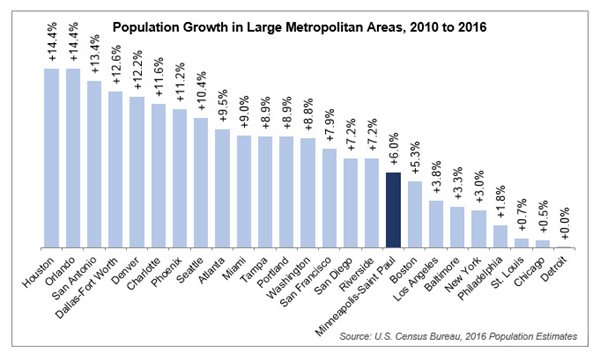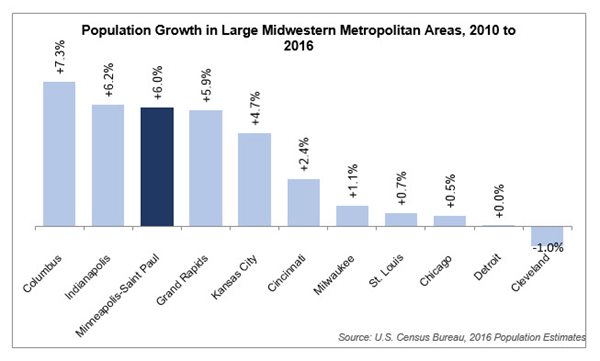U.S. Census releases county-level population information.
The estimated population of the Twin Cities region on July 1, 2016 was 3.03 million, according to information released today by the U.S. Census. The seven-county region continues to show relatively strong population growth, and Carver County’s population now exceeds 100,000.
According to Census estimates, the region’s population has increased by more than 184,000 people since April 1, 2010—a 6.5% increase. In comparison, Minnesota’s population outside the Twin Cities region has increased by 1.3% since April 1, 2010. The Twin Cities region has 55% of the state’s population but accounted for 85% of the state’s net population growth since 2010.
Among the counties in the Twin Cities region, Hennepin County had the largest numerical population increase (+80,058), while Scott County had the highest percentage growth in population (+10.6%).
|
|
Total population
|
|
Change in population, 2010‑2016
|
|
|
4/1/2010 (2010 Census)
|
7/1/2016 (estimated)
|
|
#
|
%
|
Minnesota
|
5,303,925
|
5,519,952
|
|
+216,027
|
+4.1%
|
Greater Minnesota
|
2,454,358
|
2,486,318
|
|
+31,960
|
+1.3%
|
Twin Cities region
|
2,849,567
|
3,033,634
|
|
+184,067
|
+6.5%
|
Anoka County
|
330,844
|
345,957
|
|
+15,113
|
+4.6%
|
Carver County
|
91,042
|
100,262
|
|
+9,220
|
+10.1%
|
Dakota County
|
398,552
|
417,486
|
|
+18,934
|
+4.8%
|
Hennepin County
|
1,152,425
|
1,232,483
|
|
+80,058
|
+6.9%
|
Ramsey County
|
508,640
|
540,649
|
|
+32,009
|
+6.3%
|
Scott County
|
129,928
|
143,680
|
|
+13,752
|
+10.6%
|
Washington County
|
238,136
|
253,117
|
|
+14,981
|
+6.3%
|
About two-thirds of the Twin Cities region’s estimated population growth came from “natural increase” (more people are being born than are dying). The remainder of the increase came from international migration (more people are moving into the region from outside the U.S. than are moving out).
Later this year, the Metropolitan Council will issue its own population estimates for cities and towns in the metro area, using the Census information as a resource. Local units of government will review the draft estimates in May and the Council will certify and release the estimates publicly in July.
Growth in 16-county MSA ranks 17th compared with other comparable regions
More broadly, the 16-county Metropolitan Statistical Area (MSA) has experienced the 17th-fastest growth rate (+6.0%) among the country’s 25 most populous metropolitan areas. This is faster than the nation as a whole (+4.7%) as well as some older, more established metropolitan areas like Boston, New York, and Chicago, but it is slower than peer regions like Denver, Seattle, and Portland.
In addition to the seven counties in the Twin Cities region, the 16-county MSA includes Chisago, Isanti, Le Sueur, Mille Lacs, Sherburne, Sibley, and Wright Counties in Minnesota and Pierce and St. Croix Counties in Wisconsin. According to the Census Bureau’s 2016 population estimates, the Twin Cities region constitutes 85% of the 16-county metropolitan area’s population and 91% of the metropolitan area’s net population growth since 2010.
Among major metropolitan areas in the Midwest (those with an estimated population of at least one million), the growth rate in the Minneapolis-Saint Paul MSA is the third-highest, below only Columbus (+7.3%) and Indianapolis (+6.2%).
